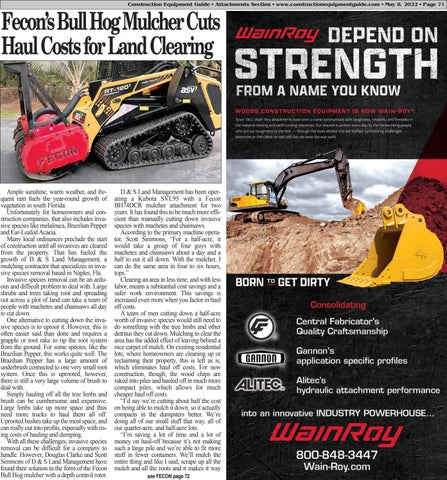Construction Equipment Guide • Attachments Section • www.constructionequipmentguide.com • May 8, 2022 • Page 71
Fecon’s Bull Hog Mulcher Cuts Haul Costs for Land Clearing
Ample sunshine, warm weather, and frequent rain fuels the year-round growth of vegetation in south Florida. Unfortunately for homeowners and construction companies, that also includes invasive species like melaleuca, Brazilian Pepper and Ear-Leafed Acacia. Many local ordinances preclude the start of construction until all invasives are cleared from the property. That has fueled the growth of D & S Land Management, a mulching contractor that specializes in invasive species removal based in Naples, Fla. Invasive species removal can be an arduous and difficult problem to deal with. Large shrubs and trees taking root and spreading out across a plot of land can take a team of people with machetes and chainsaws all day to cut down. One alternative to cutting down the invasive species is to uproot it. However, this is often easier said than done and requires a grapple or root rake to rip the root system from the ground. For some species, like the Brazilian Pepper, this works quite well. The Brazilian Pepper has a large amount of underbrush connected to one very small root system. Once this is uprooted, however, there is still a very large volume of brush to deal with. Simply hauling off all the tree limbs and brush can be cumbersome and expensive. Large limbs take up more space and thus need more trucks to haul them all off. Uprooted bushes take up the most space, and can really cut into profits, especially with rising costs of hauling and dumping. With all these challenges, invasive species removal can be difficult for a company to handle. However, Douglas Clarke and Scott Simmons of D & S Land Management have found their solution in the form of the Fecon Bull Hog mulcher with a depth control rotor.
D & S Land Management has been operating a Kubota SVL95 with a Fecon BH74DCR mulcher attachment for two years. It has found this to be much more efficient than manually cutting down invasive species with machetes and chainsaws. According to the primary machine operator, Scott Simmons, “For a half-acre, it would take a group of four guys with machetes and chainsaws about a day and a half to cut it all down. With the mulcher, I can do the same area in four to six hours, tops.” Clearing an area in less time, and with less labor, means a substantial cost savings and a safer work environment. This savings is increased even more when you factor in haul off costs. A team of men cutting down a half-acre worth of invasive species would still need to do something with the tree limbs and other detritus they cut down. Mulching to clear the area has the added effect of leaving behind a nice carpet of mulch. On existing residential lots, where homeowners are cleaning up or reclaiming their property, this is left as is, which eliminates haul off costs. For new construction, though, the wood chips are raked into piles and hauled off in much more compact piles, which allows for much cheaper haul off costs. “I’d say we’re cutting about half the cost on being able to mulch it down, so it actually compacts in the dumpsters better. We’re doing all of our small stuff that way, all of our quarter-acre, and half-acre lots. “I’m saving a lot of time and a lot of money on haul-off because it’s not making such a large pile and we’re able to fit more stuff in fewer containers. We’ll mulch the entire thing and like I said, scrape up all the mulch and all the roots and it makes it way see FECON page 72










